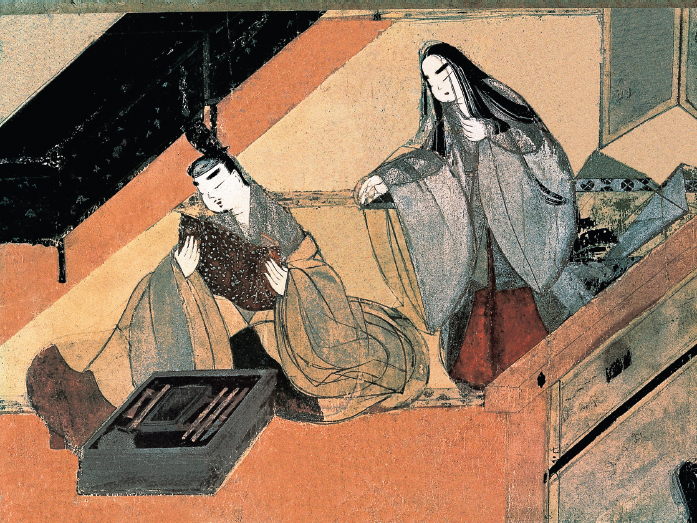Aristocratic Culture
A brilliant aristocratic culture developed in the Heian period. In the capital at Heian, nobles, palace ladies, and imperial family members lived a highly refined and leisured life. In their society, niceties of birth, rank, and breeding counted for everything. The elegance of one’s calligraphy and the allusions in one’s poems were matters of intense concern to both men and women at court. Courtiers did not like to leave the capital, and some like the court lady Sei Shonagon shuddered at the sight of ordinary working people.
In this period a new script was developed for writing Japanese phonetically. Each symbol was based on a simplified Chinese character and represented one of the syllables used in Japanese. Although “serious” essays, histories, and government documents continued to be written in Chinese, less formal works such as poetry and memoirs were written in Japanese. Mastering the new writing system took much less time than mastering writing in Chinese and aided the spread of literacy, especially among women in court society.
In the Heian period, women played important roles at all levels of society. Women educated in the arts and letters could advance at court as attendants to the ruler’s empress and other consorts. Women could inherit property from their parents, and they would compete with their brothers for shares of the family property. In political life, marrying a daughter to an emperor or shogun (see “What were the causes and consequences of military rule in Japan?”) was one of the best ways to gain power, and women often became major players in power struggles.
The literary masterpiece of this period is The Tale of Genji, written in Japanese by Lady Murasaki over several years (ca. 1000–

Murasaki was one of many female writers in this period. The wife of a high-
Buddhism remained very strong throughout the Heian period. A mission sent to China in 804 included two monks in search of new texts. One of the monks, Saichō, spent time at the monasteries on Mount Tiantai and brought back the Buddhist teachings associated with that mountain (called Tendai in Japanese). Tendai’s basic message is that all living beings share the Buddha nature and can be brought to salvation. Once back in Japan, Saichō established a monastery on Mount Hiei outside Kyoto, which grew to be one of the most important monasteries in Japan. By the twelfth century this monastery and its many branch temples had vast lands and a powerful army of monk-
Kūkai, the other monk on the 804 mission to China, came back with texts from another school of Buddhism — Shingon, “True Word,” a form of Esoteric Buddhism. Esoteric Buddhism is based on the idea that teachings containing the secrets of enlightenment had been secretly transmitted from the Buddha. People can gain access to these mysteries through initiation into the mandalas (cosmic diagrams), mudras (gestures), and mantras (verbal formulas). On his return to Japan, Kūkai attracted many followers and was allowed to establish a monastery at Mount Kōya, south of Osaka. The popularity of Esoteric Buddhism was a great stimulus to Buddhist art.
>QUICK REVIEW
What were the key characteristics of Fujiwara government? How did Fujiwara government represent a departure from Chinese models of political development?